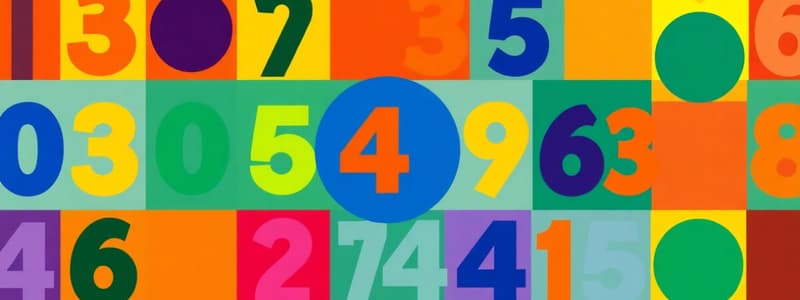Podcast
Questions and Answers
What is the common difference in the arithmetic sequence: 5, 10, 15, 20...?
What is the common difference in the arithmetic sequence: 5, 10, 15, 20...?
- 2
- 3
- 10
- 5 (correct)
A geometric sequence involves adding or subtracting a common difference between consecutive terms.
A geometric sequence involves adding or subtracting a common difference between consecutive terms.
False (B)
What type of pattern is formed by the sequence: 1, 4, 9, 16...?
What type of pattern is formed by the sequence: 1, 4, 9, 16...?
squares of consecutive integers
Tessellations are patterns that involve repeating shapes to cover a surface without gaps or ______.
Tessellations are patterns that involve repeating shapes to cover a surface without gaps or ______.
Match the following pattern types with their descriptions:
Match the following pattern types with their descriptions:
Which of the following is NOT an example of a geometric pattern?
Which of the following is NOT an example of a geometric pattern?
Shape patterns always involve changes in size only.
Shape patterns always involve changes in size only.
What are the two mathematical operations that define arithmetic sequences?
What are the two mathematical operations that define arithmetic sequences?
What characteristic is common in fractal patterns?
What characteristic is common in fractal patterns?
Flashcards
Number pattern
Number pattern
A sequence of numbers that follows a specific rule or formula. Each number in the sequence is related to the previous one by a consistent pattern.
Arithmetic sequence
Arithmetic sequence
A number pattern where the difference between consecutive terms is constant. This constant difference is called the 'common difference'.
Geometric sequence
Geometric sequence
A number pattern where each term is obtained by multiplying the previous term by a constant value. This constant value is called the 'common ratio'.
Shape pattern
Shape pattern
Signup and view all the flashcards
Tessellations
Tessellations
Signup and view all the flashcards
Fractal patterns
Fractal patterns
Signup and view all the flashcards
Spiral patterns
Spiral patterns
Signup and view all the flashcards
Visualizing number patterns
Visualizing number patterns
Signup and view all the flashcards
Predicting patterns
Predicting patterns
Signup and view all the flashcards
Developing new concepts
Developing new concepts
Signup and view all the flashcards
Study Notes
Number Patterns
- Sequences of numbers following a rule or formula are called number patterns.
- Arithmetic sequences involve adding or subtracting a common difference between consecutive terms.
- Geometric sequences involve multiplying or dividing by a common ratio between consecutive terms.
- Examples of number patterns include:
- 2, 4, 6, 8... (arithmetic, common difference is 2)
- 3, 6, 12, 24... (geometric, common ratio is 2)
- 1, 4, 9, 16... (squares of consecutive integers, follows a specific mathematical pattern)
- Understanding number patterns helps predict future terms in the sequence.
- Recognizing patterns allows for the derivation of the formulas that describe them.
Shape Patterns
- Shape patterns involve repeating or transforming shapes according to a rule or formula.
- One shape or group of shapes may be repeated in a sequence, or shapes may be changed in size, position, or orientation.
- Examples of geometric patterns include:
- Tessellations (repeating shapes to cover a surface without gaps or overlaps)
- Fractal patterns, which have self-similar structures at different scales (e.g., the Mandelbrot set)
- Spiral patterns, which appear in nature (e.g., nautilus shells)
- Understanding shape patterns frequently involves translating the pattern into an algebraic description of the relationships between the elements and properties of the shapes.
- Determining the overall characteristics of the patterns can be used to predict future elements in the sequence.
- Symmetry and transformations (rotations, reflections, translations) play a role in many shape patterns.
Relationships Between Number and Shape Patterns
- Number patterns can often be visualized using shape patterns. For instance, the triangular numbers can be represented by arranging dots into triangles, or Pascal's Triangle, which reveals patterns in binomial coefficients, can also be visually displayed.
- Geometric sequences can be represented by sequences of shapes, where the size or area of the shapes increases or decreases by a common ratio.
- Recognizing both number and shape patterns often helps solidify understanding of mathematical principles and concepts by providing a tangible, visual representation.
- The discovery of particular patterns in numbers and shapes can lead to the development of new mathematical concepts and tools.
Studying That Suits You
Use AI to generate personalized quizzes and flashcards to suit your learning preferences.




